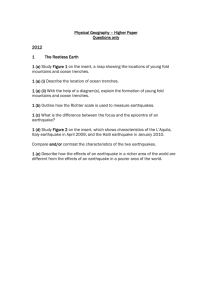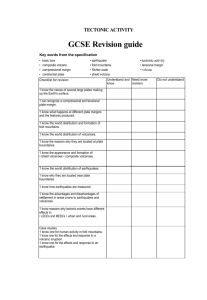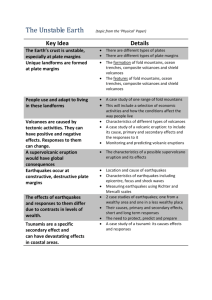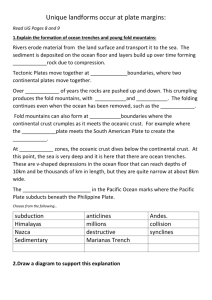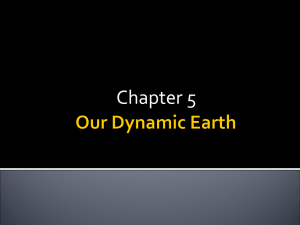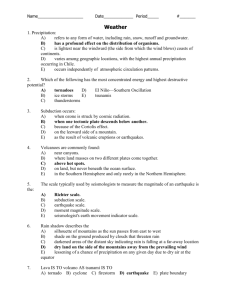GCSE Questions from all past papers The Restless Earth Foundation
advertisement
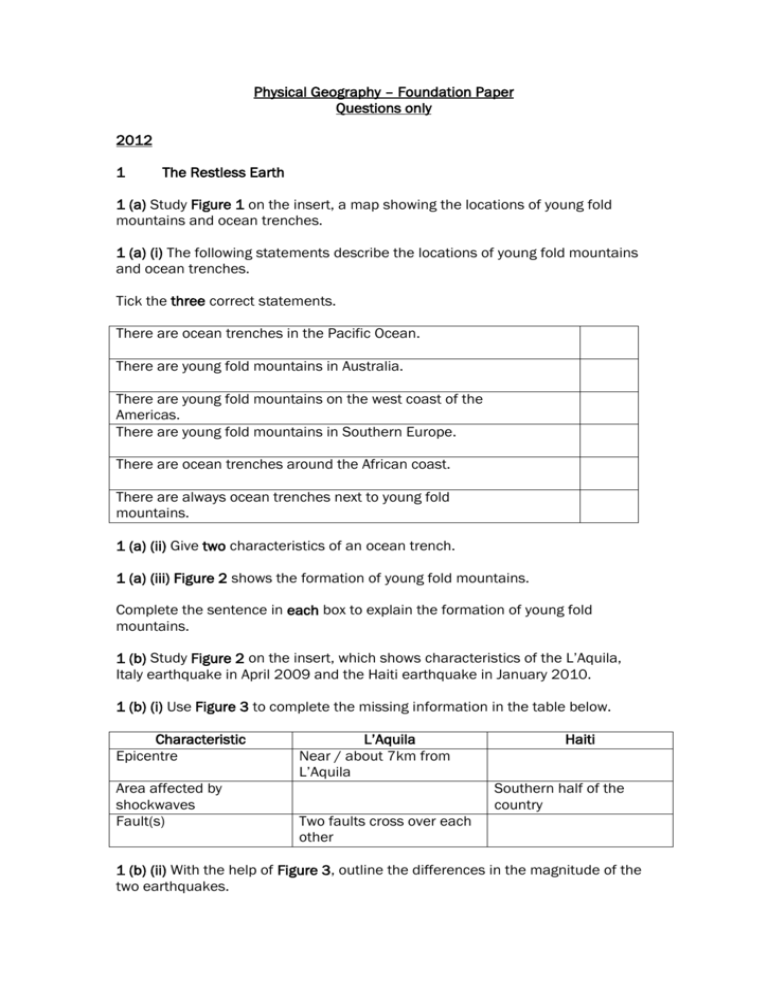
Physical Geography – Foundation Paper Questions only 2012 1 The Restless Earth 1 (a) Study Figure 1 on the insert, a map showing the locations of young fold mountains and ocean trenches. 1 (a) (i) The following statements describe the locations of young fold mountains and ocean trenches. Tick the three correct statements. There are ocean trenches in the Pacific Ocean. There are young fold mountains in Australia. There are young fold mountains on the west coast of the Americas. There are young fold mountains in Southern Europe. There are ocean trenches around the African coast. There are always ocean trenches next to young fold mountains. 1 (a) (ii) Give two characteristics of an ocean trench. 1 (a) (iii) Figure 2 shows the formation of young fold mountains. Complete the sentence in each box to explain the formation of young fold mountains. 1 (b) Study Figure 2 on the insert, which shows characteristics of the L’Aquila, Italy earthquake in April 2009 and the Haiti earthquake in January 2010. 1 (b) (i) Use Figure 3 to complete the missing information in the table below. Characteristic Epicentre Area affected by shockwaves Fault(s) L’Aquila Near / about 7km from L’Aquila Haiti Southern half of the country Two faults cross over each other 1 (b) (ii) With the help of Figure 3, outline the differences in the magnitude of the two earthquakes. 1 (c) Describe how earthquakes are measured using the Mercalli Scale. 1 (d) Describe how the effects of an earthquake in a richer area of the world are different from the effects of an earthquake in a poorer area o the world. 2011 1 The Restless Earth 1 (a) Are the following statements about continental crust and oceanic crust true or false? True False Oceanic crust can be destroyed Oceanic crust is generally lighter than continental crust. Continental crust is generally older than oceanic crust. 1 (b) (i) Study Figure 1 on the insert, a photograph of Mount Vesuvius, a volcano in Italy. Three characteristics of the volcano are shown by X, Y and Z on Figure 1. Write labels for X, Y and Z. X…………………………………………………………………………………………………………………........ Y........................................................................................................................................ Z……………………………………………………………………………………………………………………….. 1 (b) (ii) Is the volcano shown in Figure 1 a composite of a shield volcano? Circle the correct answer. Composite Shield 1 (b) (iii) Figure 2 shows that volcanoes are formed at constructive plate boundaries. Write a sentence in each box why volcanoes occur at constructive plate boundaries. 1 (c) (i) Describe the size and shape of a supervolcano. 1 (c) (ii) Describe the likely worldwide effects of a supervolcano eruption. 1 (d) (i) Study Figure 3 on the insert, photographs of how people use fold mountains. Choose one of the photographs – A, B, C or D. Describe how people are using fold mountains in the photograph you have chosen. Photograph chosen……………………………………………………………………………………………. 1 (d) (ii) Fold mountain areas suffer from limited communications, steep slopes and poor soils. Describe how people have coped with one or more of these problems. 2010 1 The Restless Earth 1 (a) Study Figure 1 which shows the Earth’s tectonic plates and the places where earthquakes occur. 1 (a) (i) Are the following statements about the distribution of earthquakes true or false? Tick the correct boxes. True False Earthquakes occur in lines. Earthquakes never occur away from plate boundaries. Earthquakes occur around the edge of the Pacific Ocean. 1 (a) (ii) On Figure 1, the letter A is on a plate boundary. What type of plate boundary is shown by the letter A? Circle the correct type in the following list. Conservative Constructive Destructive 1 (a) (iii) Complete the paragraph below to explain why earthquakes occur at conservative plate boundaries. Choose the correct words from this list. apart from jerking different lava slide past parallel with pressure smooth At conservative plate boundaries, plates move………………………….. each other. They………………………………. each other. The plates often stick and ……………………………. builds up. The sudden release of the plates causes a ……………………………. movement and an earthquake occurs. 1 (b) Study Figure 2, on the insert, a 1:50000 Ordnance Survey map extract of Market Rasen, Lincolnshire. An earthquake struck Market Rasen of 27 February 2008. Figure 3 is a sketch map drawn from Figure 2. 1 (b) (i) The epicentre of the earthquake was 4km north of the railway station in Market Rasen. On Figure 3, mark the position of the epicentre with the letter X. 1 (b) (ii) Damage was reported to Legsby parish church in grid square 1385 and to the chimneys of houses at grid reference 108892. On Figure 3, draw two arrows to show where this damage occurred. Label these arrows with the correct letters Y ans X from the key. 1 (b) (iii) The earthquake measured 5.2 on the Richter Scale. With the help of Figure 2 and your own knowledge, explain why the damage was limited. 1 (c) (i) Explain why a tsunami is a secondary effect of plate movement 1 (c) (ii) Use a case study of a tsunami to describe its effects on coastal areas.
